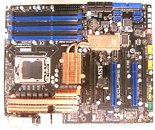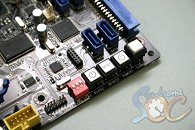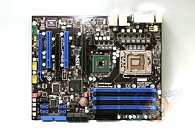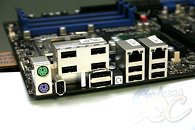- Joined
- Oct 9, 2007
- Messages
- 47,233 (7.55/day)
- Location
- Hyderabad, India
| System Name | RBMK-1000 |
|---|---|
| Processor | AMD Ryzen 7 5700G |
| Motherboard | ASUS ROG Strix B450-E Gaming |
| Cooling | DeepCool Gammax L240 V2 |
| Memory | 2x 8GB G.Skill Sniper X |
| Video Card(s) | Palit GeForce RTX 2080 SUPER GameRock |
| Storage | Western Digital Black NVMe 512GB |
| Display(s) | BenQ 1440p 60 Hz 27-inch |
| Case | Corsair Carbide 100R |
| Audio Device(s) | ASUS SupremeFX S1220A |
| Power Supply | Cooler Master MWE Gold 650W |
| Mouse | ASUS ROG Strix Impact |
| Keyboard | Gamdias Hermes E2 |
| Software | Windows 11 Pro |
The high-end offering by MSI based on the upcoming Intel X58 chipset and the 1366-pin land grid array (LGA 1366) is pictured in its full capacity. It brings with it a fascinating set of features and is slated for Q4 2008. Like all the other X58 motherboards, the Eclipse supports QuickPath Interconnect, an FSB-replacement by Intel for the LGA 1366 processors, offering system bus bandwidth around twice as that of FSB 1600 MHz, 25 GB/s.


The board is a sprawling metropolis with 6 + 4 phase power circuitry, additional SATA interfaces. It's becoming a common feature for motherboard vendors to provide switches for power, reset, and sometimes clear CMOS functions. The ASUS Rampage Extreme saw that being taken to the next level with manual overclocking controls on the board. This board shows a button labeled "Turbo1", word is that system chassis manufacturers will also be including this button on their cases soon. Perhaps it has something to do with the "Turbo Mode" CPU parameter adjustment feature (covered here). So it's back to using a quick turbo button to make your CPU act differently to different situations like it used to be in the good old days of the pre-Pentium computing. Also can be seen are DIP switches, going by the switch-cluster's label on the PCB that reads "CPU CLK1", it should have something to do with CPU parameters, again, merely to tune it, not to configure your motherboard to a new CPU. Remember, back in those days, if you upgraded from say a 33 MHz 486 DX to a 66 MHz DX2, you had to change a lot of jumpers and tune those DIP switches to make the board support a the newer CPU, updates to the BIOS handle CPU support these days, those switches are merely to tune a supported CPU.
MSI lavishly used heatsinks and heatpipe arrays to keep sensitive parts of the motherboard under thermal control. As with other X58 boards, this one features 6 DDR3 DIMM slots for 3-channel DDR3 memory. There are three PCI-Express 2.0 x16 slots, though the third blue slot doesn't seem to have lane parity with the other two black ones, which should be full electrical 16-lane interfaces. There are contradicting images of the third slot, only with official specs. being relased from MSI can there be some clarity. The board provides a total of 12 SATA interfaces, with two being eSATA. With ASUS, Gigabyte and MSI ready with their premium offerings to pave way for a new architecture, these are exciting times for the PC enthusiast.


View at TechPowerUp Main Site


The board is a sprawling metropolis with 6 + 4 phase power circuitry, additional SATA interfaces. It's becoming a common feature for motherboard vendors to provide switches for power, reset, and sometimes clear CMOS functions. The ASUS Rampage Extreme saw that being taken to the next level with manual overclocking controls on the board. This board shows a button labeled "Turbo1", word is that system chassis manufacturers will also be including this button on their cases soon. Perhaps it has something to do with the "Turbo Mode" CPU parameter adjustment feature (covered here). So it's back to using a quick turbo button to make your CPU act differently to different situations like it used to be in the good old days of the pre-Pentium computing. Also can be seen are DIP switches, going by the switch-cluster's label on the PCB that reads "CPU CLK1", it should have something to do with CPU parameters, again, merely to tune it, not to configure your motherboard to a new CPU. Remember, back in those days, if you upgraded from say a 33 MHz 486 DX to a 66 MHz DX2, you had to change a lot of jumpers and tune those DIP switches to make the board support a the newer CPU, updates to the BIOS handle CPU support these days, those switches are merely to tune a supported CPU.
MSI lavishly used heatsinks and heatpipe arrays to keep sensitive parts of the motherboard under thermal control. As with other X58 boards, this one features 6 DDR3 DIMM slots for 3-channel DDR3 memory. There are three PCI-Express 2.0 x16 slots, though the third blue slot doesn't seem to have lane parity with the other two black ones, which should be full electrical 16-lane interfaces. There are contradicting images of the third slot, only with official specs. being relased from MSI can there be some clarity. The board provides a total of 12 SATA interfaces, with two being eSATA. With ASUS, Gigabyte and MSI ready with their premium offerings to pave way for a new architecture, these are exciting times for the PC enthusiast.


View at TechPowerUp Main Site
Last edited:







